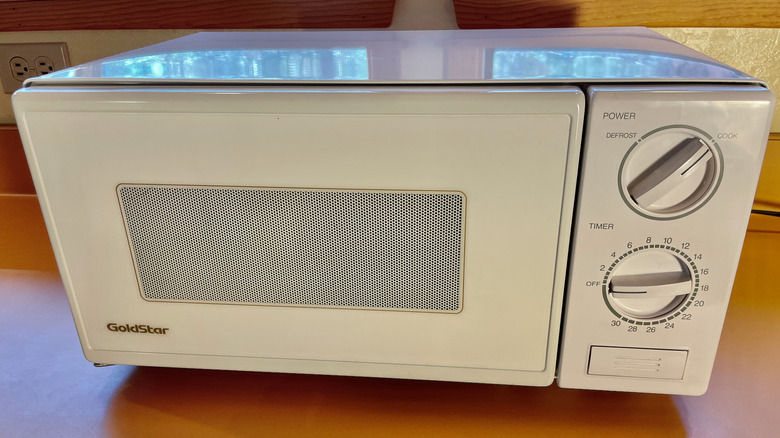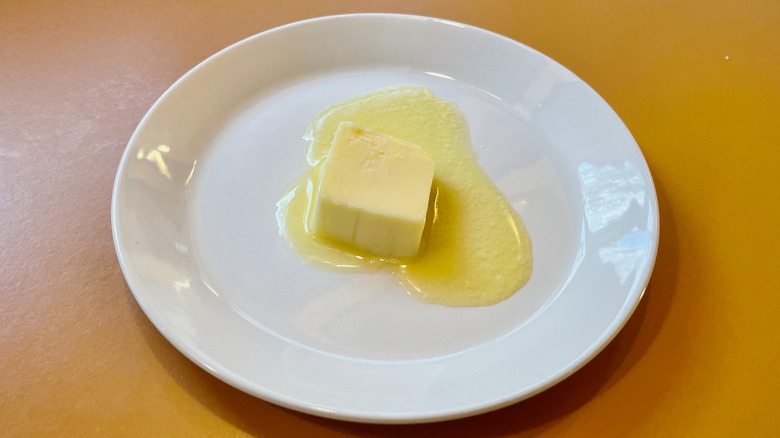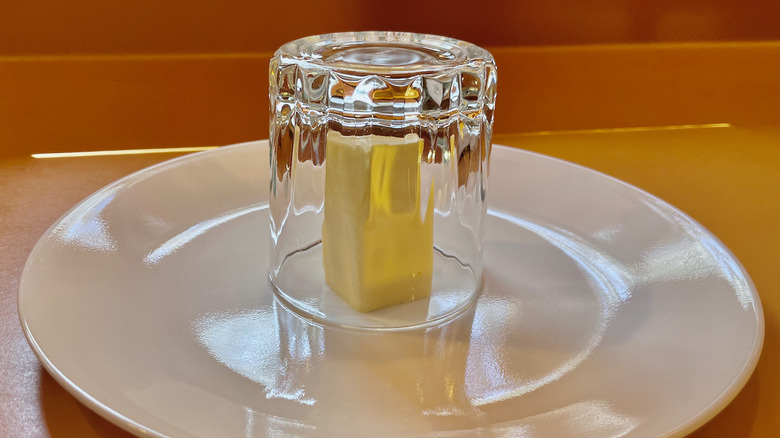We’ve all had this happen: You want to make a recipe that calls for softened butter, but you didn’t have the forethought to pull the fat out of the fridge a few hours before baking time to make sure it reached room temperature. In a state of panic, you try to soften your sticks of butter in the microwave, only for them to transition from a solid to a liquid state almost instantly, leaving an oily mess in your appliance.
In his blog The Spalenka Letters, Josef Spalenka advocates for an innovative solution to this problem: constructing a tripod out of toothpicks to elevate your butter away from the plate it’s sitting on. Spalenka says that doing this ensures that your butter will emerge from the microwave perfectly softened rather than partially melted. This butter hack seems too good to be true, but we decided to test it out to see if it actually worked, and we were surprised by the results of the experiment.
Softened butter is necessary for many recipes

Why do you even need to soften butter? We all know the pain of trying to spread rock-hard butter onto a soft piece of bread, so it’s self-evident why you would want it to be room temperature for that purpose. But softened butter has another, even more crucial application: baking.
Specifically, you want room temperature butter when you’re making cakes and cookies using the creaming method. In these recipes, the butter acts as one of the leaveners, giving your baked goods the light, fluffy texture you’re looking for. Creaming butter involves whipping it together with sugar before adding the other ingredients. The grains of sugar actually help to punch holes into the butter as you whip, helping it hold more air and giving you a lighter final result.
The acceptable temperature range for perfect creaming consistency is rather narrow. If your butter is too cold, it won’t whip. If it’s too warm it starts to separate and get greasy (or even melt), and it won’t hold air. That’s why it’s so important to soften your butter carefully.
Softening butter in the microwave is hard because microwaves heat unevenly

The microwave is the fastest way to heat up almost any kind of food, so it’s a natural tool to reach for when you’re trying to soften butter in a hurry. However, it’s not the ideal appliance for the job due to the physics behind how it works.
Microwave ovens contain magnetrons that generate microwave radiation. This radiation shoots into the oven’s chamber and hits the food, transferring energy into any sugar, fat, or water molecules present in what you’re trying to cook.
Butter is mostly fat, so the microwave radiation has no problem heating it up. However, microwaves have a limited ability to penetrate beyond the surface of food. That means they make the outside of food hot really fast, and then the energy from the exterior of the food slowly spreads to the inside. This is the opposite of what you want for softening butter, because by the time the inside of the stick warms up, the outside will be an oily puddle.
The theory behind the tripod trick

Josef Spalenka’s idea for the tripod trick was inspired by an observation he made about the way butter melted when he tried softening it in the microwave. He noticed that, without fail, the butter always started liquifying at the bottom. He theorized that the problem could be solved if he could prevent the butter from touching the plate — he noticed the same melting pattern even for butter that was sitting on fridge-cold plates that didn’t get hot in the microwave.
Spalenka settled on impaling the butter on three toothpicks arranged in a tripod formation because it was a quick and easy way to prop the butter up fully clear of the plate. Even better, he claims that the tripod technique also gives you a built-in way to tell if your butter is properly softened. As the butter heats up, it loosens its grip on the toothpicks; once the tripod falls over, the butter should be perfectly soft.
Does the butter next to the plate really start melting first?

Crawford Smith/Look
To see whether this hack was the real deal or just another piece of internet fakery, we first decided to test whether butter does indeed melt plate-side first in the microwave. We placed a pat of butter straight from the fridge onto a room-temperature ceramic plate that we knew from past experience did not get hot in the microwave at all. The plate with butter went into the microwave at full power, and we watched it like a hawk as the appliance did its work.
At the first sign of melting, we pulled out the butter, and lo and behold, the bottom had started melting while the top of the pat was still cold. The plate itself had remained at room temperature. This only took less than half a minute of microwaving total, and the butter went from completely solid to partially liquid in the span of just a couple of seconds. The first part of Spalenka’s theory checked out, so we moved on to building our butter tripod.
The verdict: Does the tripod trick work?

Having never done this before, it was slightly challenging to construct our tripod. We had to readjust our toothpicks a bit to make a stable base and our fingers became unpleasantly greasy in the process. This was annoying, but our tripod worked just as we were led to expect. After a brief spin in the microwave, the toothpick legs started to splay out and then the tripod flipped over. At that point, we pulled it out to reveal a soft pat of butter with no melted spots.
The microwave didn’t do a perfect job — parts of the pat were firmer than others. Still, the difference between the standard plate method and the tripod was impressive. We were able to spread the tripod butter onto a soft, fluffy piece of white sandwich bread with no difficulty.
While the tripod technique worked better than we expected, we weren’t in love with this hack. Manipulating the toothpicks was fiddly and we don’t think they would do a good job of holding up larger pieces of butter. You still need to closely watch the butter using this trick too. If you accidentally leave it in the microwave for a few seconds after the tripod has collapsed, the butter is still going to melt.
Other ways to soften butter in a hurry

If you’re looking for a way to soften butter that doesn’t require arts-and-crafts skills or are trying to warm up more butter than can easily be balanced on three toothpicks, there are plenty of other options out there. You can even use your microwave in an outside-the-box way. Rather than nuking the butter directly, heat a container of water in the microwave until it’s steaming. Once your water is hot, throw your butter into the chamber next to the hot container of water. Shut the door, but don’t turn the microwave on. The heat from the water should soften the butter pretty quickly. A similar principle can be used to soften a stick of butter inside a drinking glass: Pour hot water into the glass to heat it up, empty out the water, and then invert the glass over the butter.
Alternatively, you can apply some physical force to bring your butter up to temperature. One method is to use a rolling pin to flatten your fat into a thin disk between two sheets of waxed paper. A skinny sheet of butter should reach room temperature in a matter of minutes. A more hands-on technique (literally) is to pack the butter into a zip-top bag and squeeze the bag with your hands until it’s warm enough for creaming.







